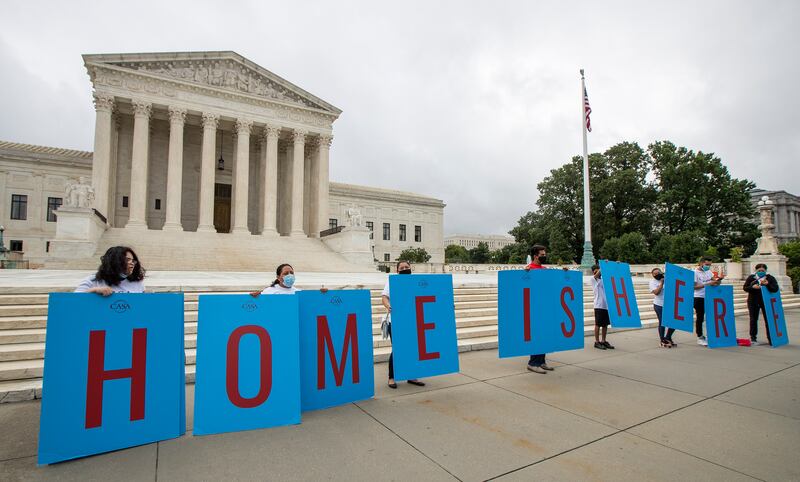The Deferred Action for Childhood Arrivals (DACA) program turned 10 years old this week but celebrations were tempered by calls for permanent solutions.
While DACA allows some of those who were brought to America by undocumented parents to stay in the country legally and work, religious leaders point out that the policy excludes many people in similar circumstances — sometimes even siblings. This situation leads to mixed-status families that live under threat of losing immediate family members to deportation, they say.
Legal challenges to the program have left DACA recipients living “in constant fear and uncertainty,” said the Interfaith Immigration Coalition in a statement.
Members of the coalition offered sharp critique of the government for leaving hundreds of thousands of young people in limbo. “No one should have to live in fear of their lives being suddenly turned upside down by abrupt policy changes,” said Barbara Weinstein, director of the Commission on Social Action of Reform Judaism, in the statement.
DACA, which was put forth under President Barack Obama, currently doesn’t provide a path to citizenship nor allow holders to participate fully in American life. For example, while participants in the program, who are also known as “Dreamers,” can attend college or university, they are not eligible for federal financial aid. In some states, DACA holders cannot get driver’s licenses. They are also locked out of a handful of professions because their temporary status means they can’t meet certification standards.
Critics of the policy say that it essentially keeps “Dreamers” in limbo for years on end. Religious leaders in this camp are continuing to call on the government for bipartisan solutions that will give DACA holders permanent status.
“Most DACA recipients still face uncertainty about their future in this country, to say nothing of their families, including hundreds of thousands of U.S.-citizen children, employers and the communities that depend on them. For those confronted by this reality, the church remains committed to walking with you and seeing this injustice remedied,” said the Rev. Mario E. Dorsonville, the auxiliary bishop of Washington who is also the chairman of the U.S. Conference of Catholic Bishops’ committee on migration, in a statement.
The Rev. Dorsonville called on Congress to come up with a “permanent solution for all “Dreamers” — one of many steps to address an immigration system in desperate need of reform.”
Other religious leaders also say that the country needs to make wide scale immigration reform. And they point out that there is broad public support — including among religious Americans — for such measures.
Asked about the potential for bipartisan efforts to “strengthen border security, create a pathway to citizenship for undocumented immigrants who came to the United States as children, and ensure a legal, reliable workforce for America’s farmers and ranchers,” 79% of Americans said they support such initiatives, according to a recent poll by the National Immigration Forum. Most of those surveyed — 72% — said they would like to see this happen before November 2022 midterm elections.
The same survey found that 81% of white evangelicals – a group that is often depicted as hostile to immigration — said they would support work on a bipartisan package that addresses the three issues of DACA, border security and migrant farmworkers, the Evangelical Immigration Table noted. Almost the same number of evangelical Protestants support a bipartisan initiative for immigration reform.
“It’s clear that it is past time for a permanent solution for “Dreamers” — one that only Congress can provide,” said the leaders of the Evangelical Immigration Table in a letter they sent to Congress this week.
Good policy solutions for all these issues already exist, the organization’s national coordinator, Matthew Soerens, told the Deseret News. He pointed to the Dream Act — bipartisan legislation, the first version of which was introduced in 2001 by then-Sen. Orrin Hatch of Utah and Illinois Democratic Sen. Dick Durbin — as well as the Farmwork Force Modernization Act of 2021 and Sen. Kyrsten Sinema and Sen. John Cornyn’s Bipartisan Border Solutions Act.
While this policy isn’t perfect, Soerens said, referring to the Bipartisan Border Solutions Act, it is “a good starting point” because it addresses the slow asylum process at the root of the problems at the border.
But for any of these policies to work, they need to be passed, he added.
“DACA has been an answer to a prayer for many, many people,” said Soerens. “But 10 years out it’s pretty clear that it’s inadequate.”
The policy, he said, was a “stopgap measure” that was supposed to be temporary.
DACA is “a band-aid on an open wound,” said the Rev. Gabriel Salguero, president of the National Latino Evangelical Coalition.
That DACA holders must periodically renew their status — and that a court decision could bring the program to an end — “leaves hundreds of thousands of people in perpetual limbo,” said the Rev. Salguero. “We in this country are better than that. We should be solutionists — we need to stop kicking the can down the road. We need bipartisanship to find permanent solutions.”
The Rev. Salguero has traveled to Capitol Hill to push for immigration reform and was with Obama a decade ago when he visited a Las Vegas high school to discuss immigration.
“I don’t do this because I’m affiliated with any political party. I do this because the gospel calls me to do it,” the Rev. Salguero told Deseret News, pointing to the Bible’s many reminders to care for the strangers among us.
Abraham and Ruth were immigrants, he added, and Jesus himself was displaced by political turmoil.
“These are not just numbers,” the Rev. Salguero said, speaking of “Dreamers.” “These are people created in the image and likeness of God.”


